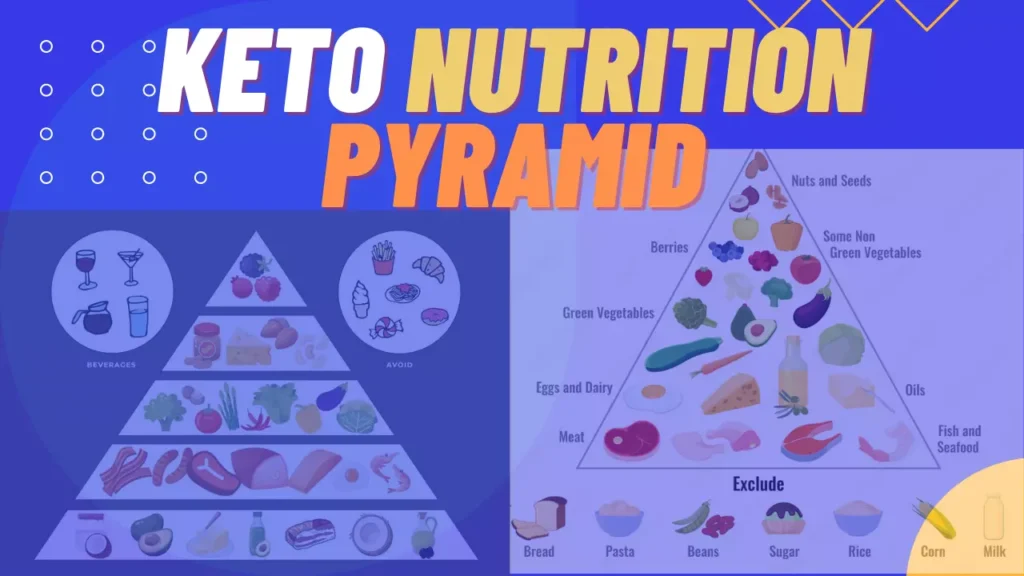Introduction
Are you tired of trying to stick to a diet, only to find yourself falling off the wagon a few weeks later? Are you looking for a sustainable and effective way to lose weight and improve your overall health? Look no further than the keto nutrition pyramid.
The ketogenic diet, or “keto” for short, is a low-carb, high-fat diet that has been shown to have numerous health benefits, including weight loss, improved blood sugar control, and reduced risk of certain diseases. However, many people struggle to stick to the diet long-term. That’s where the keto nutrition pyramid comes in.
The Keto Nutrition Pyramid: A Game-Changer for those Struggling to Stick to a Diet
The keto nutrition pyramid is a visual guide that helps you understand which foods to eat more of, and which foods to eat less of, on a ketogenic diet. The pyramid is divided into six different food groups: healthy fats, nuts and seeds, low-carb vegetables, cheese and dairy, meat and poultry, and seafood. Each group is placed in a specific layer of the pyramid, with the foods that should be consumed the most at the bottom, and the foods that should be consumed the least at the top.
Healthy Fats: The Foundation of the Keto Nutrition Pyramid
Healthy fats are the foundation of the keto nutrition pyramid. These include oils such as olive, avocado, and coconut oil, as well as nuts and seeds. Fats are an essential part of the ketogenic diet, as they provide energy, help keep you full, and support the absorption of fat-soluble vitamins.
Nuts and Seeds: A Great Source of Protein and Fiber
Nuts and seeds are a great source of protein and fiber, making them a valuable addition to the keto diet. They also provide healthy fats and minerals, such as magnesium and zinc. However, it’s important to be mindful of portion sizes, as they are high in calories.
Low-Carb Vegetables: The Key to a Balanced Keto Diet
Low-carb vegetables, such as leafy greens, broccoli, and cauliflower, are an important part of the keto nutrition pyramid. They provide essential vitamins and minerals, as well as fiber, which is important for maintaining regular bowel movements. Additionally, vegetables help to increase the volume of food, which can help you feel full on a low-carb diet.
Cheese and Dairy: A Great Source of Protein and Calcium
Cheese and dairy are a great source of protein and calcium, making them a valuable addition to the keto nutrition pyramid. However, it’s important to choose full-fat options, as they are more ketogenic. Additionally, it’s important to be mindful of portion sizes, as they are high in calories.
Meat and Poultry: A Great Source of Protein and Iron
Meat and poultry are a great source of protein and iron, making them a valuable addition to the keto nutrition pyramid. However, it’s important to choose grass-fed, organic options, as they are more ketogenic. Additionally, it’s important to be mindful of portion sizes, as they are high in calories.
Seafood: A Great Source of Omega-3 Fatty Acids
Seafood, such as salmon and sardines, is a great source of omega-3 fatty acids, making them a valuable addition to the keto nutrition pyramid. Omega-3s have been shown to have numerous health benefits, including reducing inflammation, improving brain health, and reducing the risk of heart disease. However, it’s important to be mindful of portion sizes, as they are high in calories.
Conclusion
The keto nutrition pyramid is a game-changer for those struggling to stick to a diet. It provides a visual guide for understanding which foods to eat more of, and which foods to eat less of, on a ketogenic diet. By focusing on healthy fats, nuts and seeds, low-carb vegetables, cheese and dairy, meat and poultry, and seafood, you can ensure that you are getting all the essential nutrients your body needs while staying in ketosis. By following the guidelines provided by the keto nutrition pyramid, you can achieve your weight loss and health goals in a sustainable and effective way.

Frequently Asked Questions
1. What is the keto nutrition pyramid?
The keto nutrition pyramid is a visual representation of the different food groups that should be included in a ketogenic diet. The pyramid is divided into different levels, with the base representing the foods that should be consumed in the largest amounts, and the top representing the foods that should be consumed in the smallest amounts. The base of the pyramid includes healthy fats, nuts and seeds, which are essential for providing energy and supporting overall health. These foods provide high-quality fats that promote satiety and help regulate blood sugar levels.
The next level of the pyramid includes low-carb vegetables, which are rich in fiber, vitamins, and minerals. These foods help to provide essential nutrients while keeping carbohydrate intake low. The next level includes cheese and dairy, which provide a good source of protein and fat. This group also includes fermented foods like yogurt, which provide beneficial bacteria that support gut health.
The next level of the pyramid includes meat and poultry, which provide a good source of protein and fat. These foods are also rich in vitamins and minerals such as iron, zinc, and B-vitamins. The top level of the pyramid includes seafood, which is a rich source of omega-3 fatty acids and other essential nutrients.
Overall, the keto nutrition pyramid is designed to help individuals understand which foods to eat more of and which foods to eat less of on a ketogenic diet. By following the guidelines provided by the pyramid, individuals can ensure that they are getting all the essential nutrients their body needs while staying in ketosis.
2. What are the food groups in the keto nutrition pyramid?
The food groups in the keto nutrition pyramid are specifically chosen to provide a balance of macro and micronutrients that support a ketogenic diet. The food groups are:
1. Healthy fats: This group includes oils such as olive oil, avocado oil, and coconut oil, as well as fatty foods like avocados, nuts, and seeds. These foods provide energy and support overall health by promoting satiety and regulating blood sugar levels.
2. Nuts and seeds: This group includes foods like almonds, walnuts, pumpkin seeds, and sunflower seeds. They are a great source of healthy fats, protein, and fiber, and also provide important minerals such as magnesium and zinc.
3. Low-carb vegetables: This group includes leafy greens such as spinach, kale, and broccoli, as well as other low-carb vegetables like cauliflower, zucchini, and bell peppers. These foods provide essential vitamins and minerals while keeping carbohydrate intake low.
4. Cheese and dairy: This group includes cheese, butter, and heavy cream, as well as fermented dairy products like yogurt and kefir. These foods provide a good source of protein and fat, as well as beneficial bacteria that support gut health.
5. Meat and poultry: This group includes red meat, pork, and poultry such as chicken and turkey. These foods provide a good source of protein and fat, as well as important vitamins and minerals like iron, zinc, and B-vitamins.
6. Seafood: This group includes fish and shellfish such as salmon, tuna, and shrimp. They are rich in omega-3 fatty acids and other essential nutrients such as iodine and selenium.
It’s important to note that not all keto dieters will consume all of these food groups , but the pyramid is a general guide for those who wish to follow a ketogenic diet and need help understanding what kind of food are recommended and how much of it they should consume.
3. Can I still eat fruits on a ketogenic diet?
Yes, fruits can be consumed on a ketogenic diet, but it is important to keep in mind that fruits are high in natural sugars, which can be problematic for some individuals. Therefore, it is recommended to consume fruits in moderation and to focus on low-carb fruits such as berries, which are lower in sugar than other types of fruits. Berries like raspberries, strawberries, and blackberries are high in antioxidants, vitamins, and minerals and also lower in carbs compared to other fruits.
Fruits like apples, bananas, and oranges are higher in carbs and sugar, so they should be limited or avoided on a ketogenic diet. However, if you can tolerate them, you can enjoy them in small portions. It’s important to monitor your carbohydrate intake and adjust accordingly to make sure you are staying within your daily carb limit.
It’s also important to note that even though fruits are healthy and provide important nutrients, they should not be the main focus of a ketogenic diet. The majority of your calories should come from healthy fats, protein, and low-carb vegetables.
In conclusion, while fruits can be consumed on a ketogenic diet, it’s important to consume them in moderation and focus on low-carb options such as berries, and to monitor your carbohydrate intake to make sure you are staying within your daily carb limit.
4. What are the benefits of following the keto nutrition pyramid?
The benefits of following the keto nutrition pyramid are numerous and can vary from person to person. Some of the most notable benefits include:
1. Weight loss: The ketogenic diet is known for its ability to promote weight loss by forcing the body to burn fat for fuel instead of carbohydrates. This can result in significant weight loss, particularly in the abdominal area.
2. Improved blood sugar control: By reducing carbohydrate intake and increasing fat intake, the ketogenic diet can improve blood sugar control in individuals with type 2 diabetes. This can lead to a reduction in medication use and a decrease in the risk of developing diabetes-related complications.
3. Reduced risk of certain diseases: The ketogenic diet has been shown to have a positive impact on a variety of health conditions, including cancer, heart disease, and neurological disorders. This is thought to be due to the diet’s ability to reduce inflammation, improve insulin sensitivity, and promote healthy aging.
4. Increased energy and mental clarity: Many people report increased energy and mental clarity on a ketogenic diet, as the body becomes more efficient at burning fat for fuel. The ketones that are produced during the process of ketosis can also be beneficial for brain health.
5. Better satiety and hunger control: High-fat foods like those found in the keto nutrition pyramid can help people feel full and satisfied, which can make sticking to the diet easier.
It’s important to note that the benefits of the ketogenic diet will vary from person to person and may also depend on the quality of the food that’s consumed. The keto nutrition pyramid is a great tool for ensuring that you are consuming nutrient-dense, whole foods that support overall health and well-being.
5. Is the keto nutrition pyramid suitable for vegetarians or vegans?
The keto nutrition pyramid can be adapted for vegetarians and vegans, although it may require a bit more planning and creativity. Here are a few tips on how to make the keto nutrition pyramid work for a plant-based diet:
1. Plant-based sources of protein: Vegetarians and vegans can get their protein from a variety of plant-based sources such as tofu, tempeh, lentils, quinoa, and chickpeas. These sources are also rich in fiber and other important nutrients.
2. Nuts and seeds: Nuts and seeds are excellent sources of healthy fats and protein for vegetarians and vegans. They are also high in fiber, vitamins, and minerals. Some of the best options include almonds, walnuts, chia seeds, and flax seeds.
3. Avocados: Avocados are a great source of healthy fats for vegetarians and vegans. They are also high in potassium, magnesium, and vitamin K.
4. Olive oil: Olive oil is a healthy fat that can be used to cook and dress salads. It’s high in monounsaturated fats, which have been shown to have a beneficial impact on heart health.
5. Low-carb vegetables: Vegetarians and vegans can still enjoy low-carb vegetables like leafy greens, broccoli, cauliflower, and zucchini. These can be eaten raw or cooked in a variety of ways.
6. Cheese and dairy: For vegetarians, cheese and dairy can be a great source of fat and protein. Vegan alternatives like cashew cheese and almond milk also can be a good option.
It’s important to note that being a vegetarian or vegan on a ketogenic diet can be challenging and may require more planning and preparation. It’s also important to consult a healthcare professional or a registered dietitian for guidance and support.
In conclusion, the keto nutrition pyramid can be adapted for vegetarians and vegans by focusing on plant-based sources of protein and healthy fats such as nuts and seeds, avocados, and olive oil, and low-carb vegetables. It’s important to consult a healthcare professional or a registered dietitian for guidance and support to ensure that you are getting all the necessary nutrients.
6. How often should I follow the keto nutrition pyramid?
Following the keto nutrition pyramid consistently is important for achieving the desired results, such as weight loss and improved blood sugar control. However, it’s important to note that the ketogenic diet may not be suitable for everyone and it’s always a good idea to consult with a healthcare professional before starting any new diet.
A healthcare professional can help you determine if the ketogenic diet is appropriate for you, and can also help you plan out your meals and snacks in a way that meets your nutritional needs. They may also be able to provide guidance on any potential risks or side effects of the diet, as well as monitor your progress.
Additionally, it’s important to remember that the ketogenic diet is not a short-term solution. It’s a lifestyle change that requires consistent effort and commitment. It may take some time to get used to, but with the right mindset and support, it can be a sustainable and effective way to improve your health.
In conclusion, following the keto nutrition pyramid consistently is important for achieving the desired results. However, it’s always a good idea to consult with a healthcare professional before starting any new diet, they can help you determine if the ketogenic diet is appropriate for you, and can also help you plan out your meals and snacks in a way that meets your nutritional needs.





